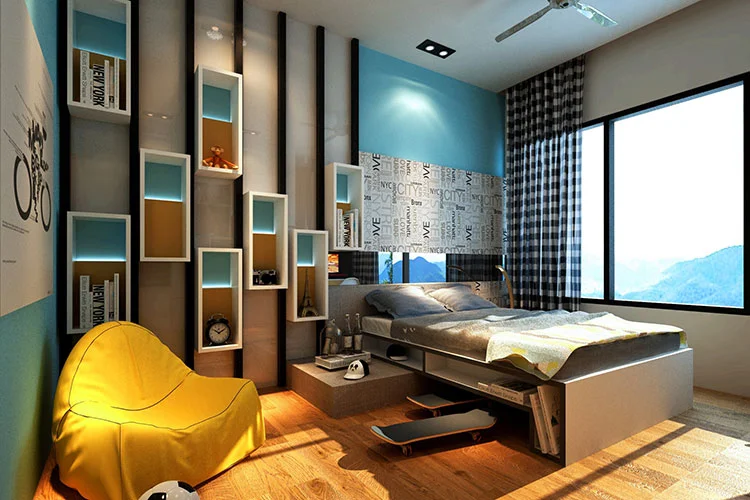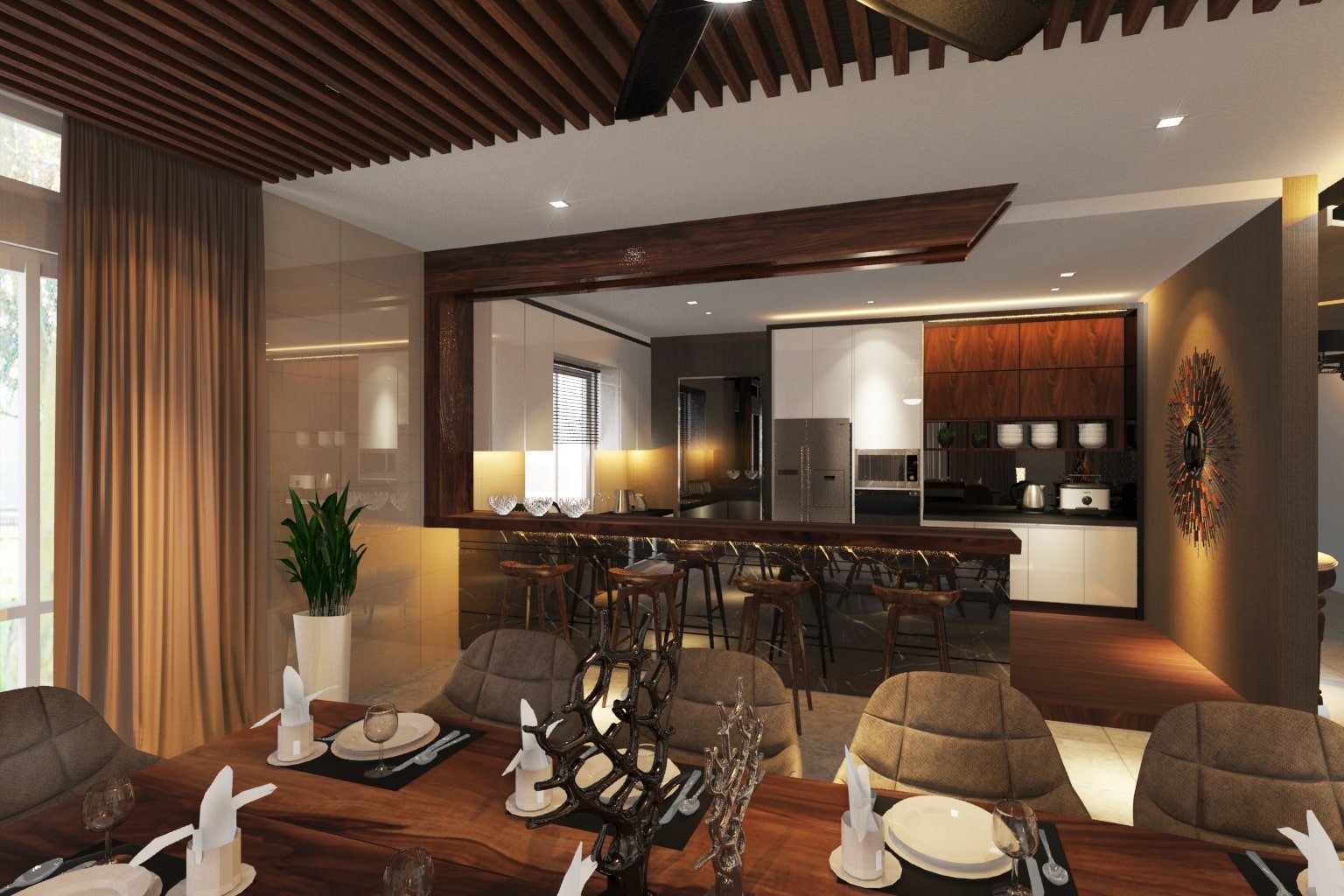Children spend more time at home than anywhere else, and nearly one-third of their lives are spent in their bedrooms.
In a child’s eyes, a great home is where love resides, memories are created, and joy and comfort can always be found. It’s no surprise that a child’s comfort experience and growth are highly influenced by their bedroom environment.
So what do you want your forever home to mean to your little ones?
Is it a place where they can look forward to quality family moments? A place where they can snuggle in their PJ’s, having popcorn while laughing at their favorite movies? Is it the feeling of warmth they feel in their hearts after a kiss goodnight? Or all of the above?
In this article, we will explore how interior architecture design synergizes with child psychology, and how it can influence the development of your child’s creativity and well-being.
1. Accessibility & Tidiness
You can feel whether a home is the ‘the right one’ for you within the first five seconds of stepping into a room.
Ideally, you’d want a room that gives a good primary impression, you want it to make you say “Yes! This is THE ONE!” and not “It’s OK, I guess.”
According to the practices of ‘Feng Shui’, there are certain ways of arranging and decorating a room that, when done right, can bring success, good luck, love, and positive energy.
For example, having a clear path in a room can make a room look more open and dynamic.
Tidiness is also something that is embraced in Feng Shui and design composition, as it accents the therapeutic aspect of being tidy in your space.
Having a clean room that allows smooth movement brings many benefits:
- It saves physical effort and time.
- improves memory, emotional effort and in turn,
- decreases stress and discomfort.
Not only that, studies have proven that children who grow up in homes with organized structure have better focus and learning abilities.
It all starts in the bedroom, so it’s important to make bedroom cleanliness part of being in a healthy growing family.
Toy crates are an outdated, dull and unengaging way to motivate today’s children to clean up after playtime. So why not opt for some more modern alternatives?
For instance, you can elect for drawers or compartments that make the most out of the space. Think bigger than space in the closets or under the bed. Hidden shelves and chambers or Lego walls are a fun way to add a personal touch to your kid’s bedroom, and will add an engaging tone to clean up time.
2. Functionality & Flexibility
Usually, when people work with a designer for a new home, they are usually in a period of big transitions in their life. For families looking to create their forever home, this is an important aspect that needs to be considered.
A child’s bedroom shouldn’t just reflect where they have been or who they are, but also where they hope to go and who they would like to be. Overdoing a theme is one of the biggest mistakes that people make when creating a child’s dream bedroom. Sure, the race car bed might excite them for a few months, but they will get bored of it quickly.
An expert knows that it’s more important to capture the essence and emotions of cherished details in a home rather than to duplicate the details themselves. By creating a space using timeless principles, the room grows older with the child, adapting with them and creating a compound effect of memories created.
So how can you add meaningful value to your child’s bedroom without cluttering and taking up space?
Rooms that have the right amount of novelty and stimulation exude a freshness that gives the home a creative energy with a modern sense that will inspire your child’s inner growth. You can also opt for furniture that can be easily moved or wall art that can be switched out over time.
By not being stuck to a specific trend of decoration, your child’s bedrooms can remain relatable despite how old they get. Making them feel they always have a room back home even they move out, which one day they can share with their own kids.
3. Nature Simulation
The organic appeal of nature and all its elements has always been loved by homeowners around the world. It evokes feelings of peace, calm and welcoming into their space.
Bringing nature into our homes is an eternal design aesthetic that brings a bespoke quality into your home.
But why is it so?
Interior designer Carolyn Feder, founder and owner of Sensory Interior Design in Dallas says that it is due to the subliminal messages sent to the brain.
Bringing the outdoors into your children’s bedroom not only serves as a source of inspiration, but images of nature’s miracles can also aid in developing kids’ attention to detail.
“Photos help children learn how to observe details around them and they learn how to appreciate everything nature does for us as a whole.”
Some ways this can be done:
- Textures inspired by nature; woolen rug, Scandinavian luxury bed frames
- Glass walls that projects moving images of nature.
- Indoor plants and water features.
- Wooden wall panels.
- Nature’s color palette throughout the room.
After all, your kids spend a majority of their time indoors in artificial environments, adding a dash of nature will help heal and remind us of our roots.
4. Color
It’s a no brainer that color is a significant effect on your mood, as color psychologists will tell you. In interior design, this gives you a fun benefit as it means you can directly influence how your rooms affect you.
Lighter and brighter colors, like red, yellow and green are excellent for stimulating creativity and spirit. While pastels and rustic hues like beige and gray bring tranquility and calmness.
The basic purpose of a bedroom is to rest, however, kids do many other activities in the bedroom. They need an environment that can nurture their growth and exploration while promoting a calm, stress-free haven.
With such an array of options to choose from, how can you pick the perfect shade?
The answer is simple: you don’t have to.
With the help of LED lighting, you can customize the feel and atmosphere of your room using your smart phone. These are easy to install with wide variety of color choices.
Your children can have the opportunity to customize the look of your wall based on their current mindset or mood at any time.
Another way is to choose a minimalist color tone and use wall art, decorations or display shelves to add the contrasting color pop instead. That way you can leave it up to the imaginative minds of your kids how they’d like to color their room.
5. Light
One of the biggest influences in the psychology of design and space is lighting. Lighting specification can make or break the look and feel of a room, and it is for this reason designers pay close attention to the balance of natural and artificial light in a plan.
Light does two important things for growing children:
- Bright natural light boosts mood and concentration, and sufficiency of it prevents disease, and nearsightedness. This is because sunlight helps children produce adequate levels of vitamin D that is needed to prevent undesirable health outcomes such as early puberty and inferior mental planning skills.
- Morning sunlight exposure can help prevent delayed bedtimes and circadian rhythm problems. Studies suggest that delayed bedtimes -without opportunities for catch-up sleep- are linked with poor school performance and behavior problems. Improper lighting at night can also be a hazard for sleep, which is a rising concern for parents with the prevalence of blue light from smartphones for children’s entertainment.
A simple and effective solution to finding the healthy balance of light in your child’s bedroom is to have appropriate size and number of windows, along with blackout curtains and drapes that match. A dimmer switch can be installed in the light switch to ensure that you have controlled lighting.
6. Your bedroom defines who you are

Interior design can be viewed as the art of decorating a space to achieve a balance of aesthetics and functionality. However, it can also be looked at as a way of giving meaning to the space that you live in.
From the preference of color and pattern of the wallpaper to the intricate design of your jewelry box that sits on the dressing table, you can define your living space to present your personality.
According to design psychology, our sense of identity and self-perception are psychologically influenced by our physical environment. It is said that there is a complex two-sided relationship between a person and their space.
In a sense, when you define your living space, your living space defines you.
Children that grow up in a healthy familial environment have shown to display self-conscious behaviors and emotions (shame, guilt, embarrassment, pride) as early as 2 years old. As they grow in their first few years, their psychological view of themselves also develop.
Studies have revealed that children with positive perceptions of themselves grow to achieve good social and academic capabilities later on in life.
A great way to allow this is to create areas in your child’s bedroom that freely encourage their hobbies.
There are multiple ways of doing this:
- Reading corners under skylights with the simulation of nature sounds (river streams, heavy thunderstorms, birds singing, etc.)
- Interactive smart wall to display drawings and designs
- Soundproof area for playing musical instruments
- Customizable walk-in closet
- Display shelves to showcase novelties that reflect them.
So, having a strong sense of identity is crucial to your child’s development as they grow older, to nurture good self-esteem and individuality. As the bedroom is where they first learn space identity, it should reflect their unique interests and personality.
Not to mention that by surrounding themselves in a physical environment that reflects their interests, it primes them for a deep self actualization process. This will train them to be able to define the abstract part of them themselves and visualize it into a physical manifestation of their inner most desires.
7. Privacy Please!
Space privacy is another psychological impact of interior design; an individual requires a healthy degree of privacy, or they might feel discomfort, anger or anxiety. The fundamental goal of achieving privacy through design is to attain symmetry between personal time and social relationships.
During your children’s first year, it’s expected that constantly being cared for and supervised falls under the tiring role of being a parent. So it can be difficult when, a couple of years later, you have to start letting your child have their first taste of autonomy.
The need for privacy is a completely natural part of kids growing older, it comes hand in hand when they slowly learn to be independent.
Though it may be unsettling for parents, this encouragement can be beneficial to the children, as it overall builds familial trust and a sense of competence. This can later help in learning important abilities such as decision-making skills and resourcefulness as they grow older.
Here are some ideas to add a personal touch to your children’s bedrooms that can also serve as a protective measure:
- Mezzanine (sleeping and lounging quarters separated from creative areas)
- Secret closet or room.
- Sleeping quarters with windows or walls that can change from transparent glass to frosted glass.
- Partition walls that separate the room into different function areas (see photo above)
Conclusion:
Children are the backbone of the future and your legacies. As parents you want to pass on your life lessons and pave a path for your children to capitalize on what you’ve learned so they don’t have to make the same mistakes.
The same way that smaller plants grow faster when they are nearby larger trees. The trees roots act as a guideline for the smaller trees to find sources of water more easily.
You would want to prioritize your child’s health, safety and happiness throughout their years at home while living lavishly with the comfort experience that they can look forward to.
After all your forever home is something that they will take over later on in their older years and will act as a symbol for your legacy long after you’re gone.
By solidifying the lessons you want to ingrain in your children while simultaneously integrating that with their personal individuality, you end up creating a self-empowering physical environment. Which will preserve these lessons and memories that grow with your children by using healthy design psychology principles.
If you’d like to integrate some of these learning concepts into your kids bedroom designs,
Click here for a customized pricing plan from our interior design consultants in Malaysia
Or leave a comment below to share your thoughts!


